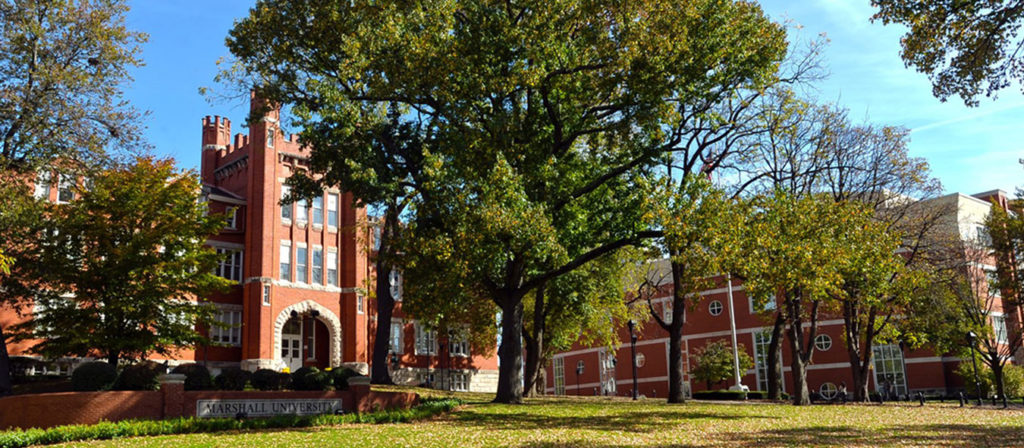The National Science Foundation (NSF) has awarded nearly $400,000 to the departments of Chemistry, Geology, Engineering, Physics, Biological Sciences, and Forensic Science at Marshall University to purchase a Field Emission Scanning Electron Microscope (SEM).
The grant was awarded through the NSF’s Major Research Instrumentation Program, established to help faculty members who need expensive research instrumentation acquire the equipment at little cost to their universities. Scanning electron microscopes allow scientists to look at surfaces and observe molecular structures at the nanometer scale.
Faculty at West Virginia State University (WVSU) and the University of Charleston (UC), as well as scientists at Alcon Laboratories and the SOGEFI Group, also participated in the grant. The team of 11 faculty members was led by Marshall Assistant Professor Dr. Rosalynn Quiñones (Chemistry) and Marshall Associate Professor Dr. Aley El-Shazly (Geology).
The microscope will make significant contributions to participating faculty members’ research programs while also being used extensively in the teaching laboratories in geology, chemistry, physics, engineering, biological sciences, and forensic science at Marshall University and chemistry at WVSU and UC.
“The research that will be enabled by the [SEM] is meritorious and spans nanoscience, geology, materials engineering, biology, and petrology,” the NSF noted. The foundation also stated, “The panel noted a strong commitment to education in the proposed outreach activities in research and training.”
“It is clear that the NSF review panel recognized the multiple benefits that will be provided by the acquisition of this instrument at Marshall,” said Dr. Charles Somerville, dean of Marshall’s College of Science. “We have a 20-plus year record of maintaining an SEM facility for teaching, research, outreach and economic development. This review panel saw our students, faculty, and community as a good investment.”
Although primarily intended as a research instrument, instructors will use the new SEM in teaching laboratories that will have a direct impact on at least 150 students annually. According to Dr. Michael Castellani, director of the Marshall’s Division of Physical Sciences, “The opportunity for so many undergraduate students across such a wide array of disciplines to use an instrument such as this in labs is unusual. Some of these students will start using the SEM in their sophomore years both in classes and research. The use of sophisticated instrumentation in teaching is one of the main tools for drawing students into research and hence improving their overall STEM education.”
The faculty members who will be using the microscopes and their projects are:
Principal and Co-Principal Investigators
Dr. Rosalynn Quiñones, Chemistry, “Study of Perfluorophosphonic Acid Surface Modifications on Zinc Oxide Nanoparticles” and “Controlling Surface Properties of Metal Oxide Nanoparticles using Self-Assembled Monolayers and Polymer Brushes.” This research involves improving semiconductor properties on metal oxides at the surface for either solar cell applications or biofilms.
Dr. Aley El-Shazly, Geology, “Tectonometamorphic Evolution of the Western Blue Ridge: Insights from the Little Pine Garnet Mine Assemblages” and “Origin of Migmatites and Dikes in the Blue Ridge, Southern Appalachians.” This research examines metamorphic rocks to better understand the origin and evolution of mountain chains.
Dr. Iyad Hijazi, Engineering, “Research in Material Science and Engineering.” This research aims to identify amorphous and core-shell metallic alloy clusters with structural stability and study their thermodynamic, electronic and magnetic properties.
Dr. Sean McBride, Physics and Physical Sciences, “Liquid-Surface Experiments on Nanometer Length Scale: Nanoparticle Stability at Liquid Interfaces,” “Liquid-Surface Experiments on Nanometer Length Scale: Flow in Confined Geometries,” and “Self-Assembled Nanoparticle Membranes: Mechanical and Properties of Self-Assembled Nanoparticle Free Standing Membranes.” This research focuses on determining the size of nanoparticles used in studies that demonstrate the wettability and mechanical properties of nanoparticle covered surfaces and membranes respectively.
Dr. Michael Norton, Chemistry, “Nanoplasmonics for Molecular Sensing.” The research involves characterizing in extreme detail metal nanostructures which, due to their electron-wave properties, change the optical behavior of molecules used to detect contaminants in the environment.
Senior Personnel
Dr. James Joy, Biological Sciences, “Employing Light Microscopy and SEM to Characterize Sensory Sensillae that Monitor Blood Flow in the Tsetse Fly (Glossina m. morsitans) Food Canal” – Employing Light Microscopy and SEM to Characterize Sensory Sensillae that Monitor Blood Flow in the Tsetse Fly (Glossina m. morsitans) Food Canal.
Dr. Victor Fet, Biological Sciences, “SEM study of Arachnid sensory morphology.” This research focuses on the discovery of novel microstructures and organs in arachnid arthropods, for example related to sensory, reproductive and digestive functions of scorpions.
Dr. Ana Peña-Alvarez, Engineering, “Investigation on the Mechanical Properties of Elastomeric Nano-Composites to be used as Flexible Actuator Materials for Soft-Robotics.” This research aims to characterize and optimize the mechanical properties at the micro- and nano-scale of flexible materials that are currently used in the development of novel robotic devices.
Originally from Jean Hardiman for Marshall University Communications.
